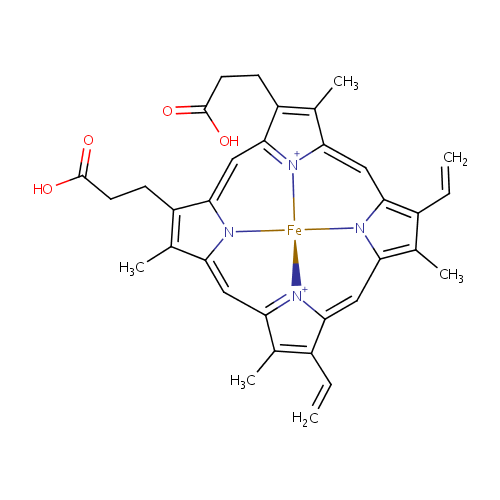
Heme (PAMDB000481)
| Record Information | ||||||||||||||||||||||||||||||||||||||||||||||||||||||||||
|---|---|---|---|---|---|---|---|---|---|---|---|---|---|---|---|---|---|---|---|---|---|---|---|---|---|---|---|---|---|---|---|---|---|---|---|---|---|---|---|---|---|---|---|---|---|---|---|---|---|---|---|---|---|---|---|---|---|---|
| Version | 1.0 | |||||||||||||||||||||||||||||||||||||||||||||||||||||||||
| Update Date | 1/22/2018 11:54:54 AM | |||||||||||||||||||||||||||||||||||||||||||||||||||||||||
| Metabolite ID | PAMDB000481 | |||||||||||||||||||||||||||||||||||||||||||||||||||||||||
| Identification | ||||||||||||||||||||||||||||||||||||||||||||||||||||||||||
| Name: | Heme | |||||||||||||||||||||||||||||||||||||||||||||||||||||||||
| Description: | Heme B or haem B (also known as protoheme IX) is the most abundant heme in nature. Pseudomonas aeruginosa is known to produce 4 different hemes: protoheme IX (heme B), heme C, heme D, and siroheme. A heme or haem is a prosthetic group that consists of an iron atom contained in the center of a large heterocyclic organic ring called a porphyrin. Not all porphyrins contain iron, but a substantial fraction of porphyrin-containing metalloproteins have heme as their prosthetic subunit; these are known as hemoproteins. Generally, heme B is attached to the surrounding protein matrix (known as the apoprotein) through a single coordination bond between the heme iron and an amino-acid side-chain. When oxygen is bound the iron becomes hexacoordinated. Since the iron in heme B containing proteins is bound to the four nitrogens of the porphyrin (forming a plane) and a single electron donating atom of the protein, the iron is often in a pentacoordinate state. | |||||||||||||||||||||||||||||||||||||||||||||||||||||||||
| Structure | ||||||||||||||||||||||||||||||||||||||||||||||||||||||||||
| Synonyms: |
| |||||||||||||||||||||||||||||||||||||||||||||||||||||||||
| Chemical Formula: | C34H32FeN4O4 | |||||||||||||||||||||||||||||||||||||||||||||||||||||||||
| Average Molecular Weight: | 616.487 | |||||||||||||||||||||||||||||||||||||||||||||||||||||||||
| Monoisotopic Molecular Weight: | 616.177297665 | |||||||||||||||||||||||||||||||||||||||||||||||||||||||||
| InChI Key: | YHLKGEDAGPGZPN-RGGAHWMASA-L | |||||||||||||||||||||||||||||||||||||||||||||||||||||||||
| InChI: | InChI=1S/C34H34N4O4.Fe/c1-7-21-17(3)25-13-26-19(5)23(9-11-33(39)40)31(37-26)16-32-24(10-12-34(41)42)20(6)28(38-32)15-30-22(8-2)18(4)27(36-30)14-29(21)35-25;/h7-8,13-16H,1-2,9-12H2,3-6H3,(H4,35,36,37,38,39,40,41,42);/q;+4/p-2/b25-13-,26-13-,27-14-,28-15-,29-14-,30-15-,31-16-,32-16-; | |||||||||||||||||||||||||||||||||||||||||||||||||||||||||
| CAS number: | 14875-96-8 | |||||||||||||||||||||||||||||||||||||||||||||||||||||||||
| IUPAC Name: | (1R)-15,19-bis(2-carboxyethyl)-5,10-diethenyl-4,9,14,20-tetramethyl-2???22,23???25-tetraaza-1-ferraoctacyclo[11.9.1.1?,??1?,??.0?,??0?????.0?????.0??,???pentacosa-2,4,6,8,10,12,14,16(23),17,19,21(24)-undecaene-2,23-bis(ylium) | |||||||||||||||||||||||||||||||||||||||||||||||||||||||||
| Traditional IUPAC Name: | Heme | |||||||||||||||||||||||||||||||||||||||||||||||||||||||||
| SMILES: | CC1=C(CCC(O)=O)C2=CC3=[N+]4C(=CC5=C(C=C)C(C)=C6C=C7C(C=C)=C(C)C8=[N+]7[Fe@]4(N2C1=C8)N56)C(C)=C3CCC(O)=O | |||||||||||||||||||||||||||||||||||||||||||||||||||||||||
| Chemical Taxonomy | ||||||||||||||||||||||||||||||||||||||||||||||||||||||||||
| Taxonomy Description | This compound belongs to the class of organic compounds known as metallotetrapyrroles. These are polycyclic compounds containing a tetrapyrrole skeleton combined with a metal atom. | |||||||||||||||||||||||||||||||||||||||||||||||||||||||||
| Kingdom | Organic compounds | |||||||||||||||||||||||||||||||||||||||||||||||||||||||||
| Super Class | Organoheterocyclic compounds | |||||||||||||||||||||||||||||||||||||||||||||||||||||||||
| Class | Tetrapyrroles and derivatives | |||||||||||||||||||||||||||||||||||||||||||||||||||||||||
| Sub Class | Metallotetrapyrroles | |||||||||||||||||||||||||||||||||||||||||||||||||||||||||
| Direct Parent | Metallotetrapyrroles | |||||||||||||||||||||||||||||||||||||||||||||||||||||||||
| Alternative Parents | ||||||||||||||||||||||||||||||||||||||||||||||||||||||||||
| Substituents |
| |||||||||||||||||||||||||||||||||||||||||||||||||||||||||
| Molecular Framework | Aromatic heteropolycyclic compounds | |||||||||||||||||||||||||||||||||||||||||||||||||||||||||
| External Descriptors | Not Available | |||||||||||||||||||||||||||||||||||||||||||||||||||||||||
| Physical Properties | ||||||||||||||||||||||||||||||||||||||||||||||||||||||||||
| State: | Solid | |||||||||||||||||||||||||||||||||||||||||||||||||||||||||
| Charge: | 0 | |||||||||||||||||||||||||||||||||||||||||||||||||||||||||
| Melting point: | Not Available | |||||||||||||||||||||||||||||||||||||||||||||||||||||||||
| Experimental Properties: |
| |||||||||||||||||||||||||||||||||||||||||||||||||||||||||
| Predicted Properties |
| |||||||||||||||||||||||||||||||||||||||||||||||||||||||||
| Biological Properties | ||||||||||||||||||||||||||||||||||||||||||||||||||||||||||
| Cellular Locations: | Cytoplasm | |||||||||||||||||||||||||||||||||||||||||||||||||||||||||
| Reactions: | Adenosine triphosphate + Water + Heme > ADP + Hydrogen ion + Phosphate + Heme Adenosine triphosphate + Water + Heme > ADP + Hydrogen ion + Phosphate + Heme Farnesyl pyrophosphate + Water + Heme > Heme O + Pyrophosphate Protoporphyrin IX + Fe2+ <> Heme +2 Hydrogen ion + Fe2+ Heme + Hydrogen peroxide Heme D Iron + Protoporphyrin IX > Heme + Hydrogen ion -->--> | |||||||||||||||||||||||||||||||||||||||||||||||||||||||||
| Pathways: | ||||||||||||||||||||||||||||||||||||||||||||||||||||||||||
| Spectra | ||||||||||||||||||||||||||||||||||||||||||||||||||||||||||
| Spectra: |
| |||||||||||||||||||||||||||||||||||||||||||||||||||||||||
| References | ||||||||||||||||||||||||||||||||||||||||||||||||||||||||||
| References: |
| |||||||||||||||||||||||||||||||||||||||||||||||||||||||||
| Synthesis Reference: | Not Available | |||||||||||||||||||||||||||||||||||||||||||||||||||||||||
| Material Safety Data Sheet (MSDS) | Not Available | |||||||||||||||||||||||||||||||||||||||||||||||||||||||||
| Links | ||||||||||||||||||||||||||||||||||||||||||||||||||||||||||
| External Links: |
| |||||||||||||||||||||||||||||||||||||||||||||||||||||||||
Enzymes
- General function:
- Involved in ferrochelatase activity
- Specific function:
- Catalyzes the ferrous insertion into protoporphyrin IX
- Gene Name:
- hemH
- Locus Tag:
- PA4655
- Molecular weight:
- 38.6 kDa
Reactions
| Protoheme + 2 H(+) = protoporphyrin + Fe(2+). |
- General function:
- Involved in nucleotide binding
- Specific function:
- Part of the ABC transporter complex CcmAB involved in the biogenesis of c-type cytochromes; once thought to export heme, this seems not to be the case, but its exact role is uncertain. Responsible for energy coupling to the transport system
- Gene Name:
- ccmA
- Locus Tag:
- PA1475
- Molecular weight:
- 25 kDa
Reactions
| ATP + H(2)O + heme(In) = ADP + phosphate + heme(Out). |
- General function:
- Involved in protein complex assembly
- Specific function:
- Required for the export of heme to the periplasm for the biogenesis of c-type cytochromes
- Gene Name:
- ccmC
- Locus Tag:
- PA1477
- Molecular weight:
- 28.3 kDa
- General function:
- Involved in heme transporter activity
- Specific function:
- Required for the export of heme to the periplasm for the biogenesis of c-type cytochromes
- Gene Name:
- ccmB
- Locus Tag:
- PA1476
- Molecular weight:
- 23.4 kDa
- General function:
- Involved in protoheme IX farnesyltransferase activity
- Specific function:
- Converts heme B (protoheme IX) to heme O by substitution of the vinyl group on carbon 2 of heme B porphyrin ring with a hydroxyethyl farnesyl side group
- Gene Name:
- cyoE
- Locus Tag:
- PA1321
- Molecular weight:
- 31.8 kDa
- General function:
- Involved in protein-heme linkage
- Specific function:
- Heme chaperone required for the biogenesis of c-type cytochromes. Transiently binds heme delivered by CcmC and transfers the heme to apo-cytochromes in a process facilitated by CcmF and CcmH
- Gene Name:
- ccmE
- Locus Tag:
- PA1479
- Molecular weight:
- 17.2 kDa

